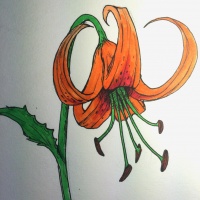| Dragonflower |
|---|
 |
| Flora |
|---|
| Official Name |
Dragonflower |
|---|
| Common Name |
Fireflower, Spice Bloom |
|---|
| Classification |
Flower |
|---|
| Common Use |
Utility, Culinary, Decorative |
|---|
| Origins |
Unknown |
|---|
| Habitat |
Humid to arid environments |
|---|
Dragonflowers are a prolific plant that has blossomed across disparate parts of Aloria for millennia. Known for their fiery colors and lust for water, the plants have been attached to many deities and systems of belief over the years. They are also best known for their uses in spicing culinary creations, but can also form fine, flashy dyes and brighten up any home. The plant’s broad spread has only grown with time, and many have embraced it as a symbol to ignite a passion in cooking, fashion, or one’s home.
History
The exact origin of the Dragonflower is unknown, though its common growth in several areas of Aloria suggests an ancient origin point now lost. The plant was first noted by the Allorn Empire sometime around 8000 BC, when the flowers were found growing in Sileria and the western reaches of Ithania’s desert. Later, Dragonflowers were found to be growing in the southern regions of the Regalian Archipelago and lastly, the continent of Farahdeen. The plant, over the millennia, grew important to many subraces and Cultures. For the Qadir, it remained a key seasoning in their cuisine, while for the Suvial, its spicy kick was adored among the mix of fierce tastes they cultivated. The Ailor embraced the flower most thoroughly of all. Dragonflowers became seen in their society as a living representation of “Dragon fire”, though few if any Dragons actually breathed that element. Regardless, the flowers that bore a draconic moniker became well known and used in the cuisine of groups like the Ithanians, Daendroque, and other southern-aligned societies. The plant could not grow in cooler climates and never caught on in such societies. Today, Dragonflowers are still consumed but are more commonly used as decoration to symbolize passion, romance, aggression, or simply because its colors are stark and beautiful. It is also sometimes used in the creation of dyes for beautiful dresses with fiery colors, which is of particular value in Farahdeen with the fire-loving Songaskians.
Appearance
Dragonflowers stand up to one and a half feet tall, with white, curling, and often moist roots anchoring them to the ground. The plant has a long, thin (yet rigid) stem. Its leaves are the most peculiar, angled outward in a curving up rhomboid, with slight spikes that give a small prick to whoever grabs at them unprepared. There are only between two to five such leaves on any one stem. The final feature of the vegetation is, of course, the Dragonflower bloom itself. It is a five-petaled flower, capable of growing up to a diameter of four inches given the right conditions, but this can be hard to measure as the petals harshly curl back from the flower’s center. The color of the petals can vary from light orange-yellows to a deep, rich scarlet. The plant has anywhere between four to six green filaments tipped with a dark brown anther which protrude from the plant, while the flower’s stigma is buried at the base, and deeper into the flower.
Uses and Abilities
The Dragonflower is primarily used for cooking, the small brown anthers quite spicy and commonly ground into Dragonspice Powder (often just called Dragonspice), a substance comparable to cayenne, paprika, or chili powders. The plant’s other use is in the creation of warm-colored dyes for clothing and fabrics, producing rich reds and oranges naturally to the delight of dye makers. Finally, there is the decorative aspect to the plant, where it is kept in pots and more both outside and inside of homes.
Trivia
- The wide spread of Dragonflower has been suggested by some to be a result of the Seraph, possibly making this species very old indeed.
- Some claim that Dragonspice Powder can make one breathe literal fire if they drop a tablespoon of the stuff directly into their mouth. This is not the case, and the resulting “fire” is often just the rapidly blasted out Powder as the prank victim rushes for the nearest source of water or milk.
|
|---|
| | Flowers | |
|---|
| | Trees | |
|---|
| | Shrubs | |
|---|
| | Grasses | |
|---|
| | Herbs | |
|---|
| | Vines | |
|---|
| | Mosses | |
|---|
| | Fungi | |
|---|
| |
|
| Accreditation |
|---|
| Writers |
HydraLana |
|---|
| Processors |
MantaRey, AlphaInsomnia |
|---|
|
| Last Editor |
HydraLana on 12/27/2023. |
|---|
|
|---|
» Read more
